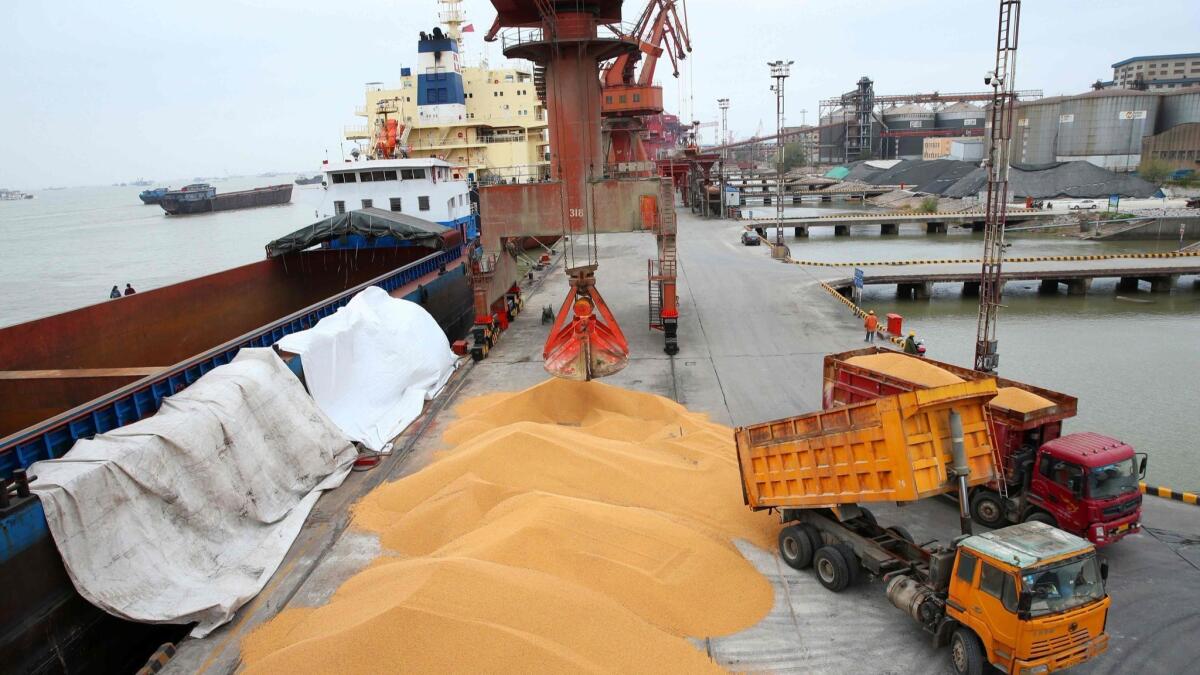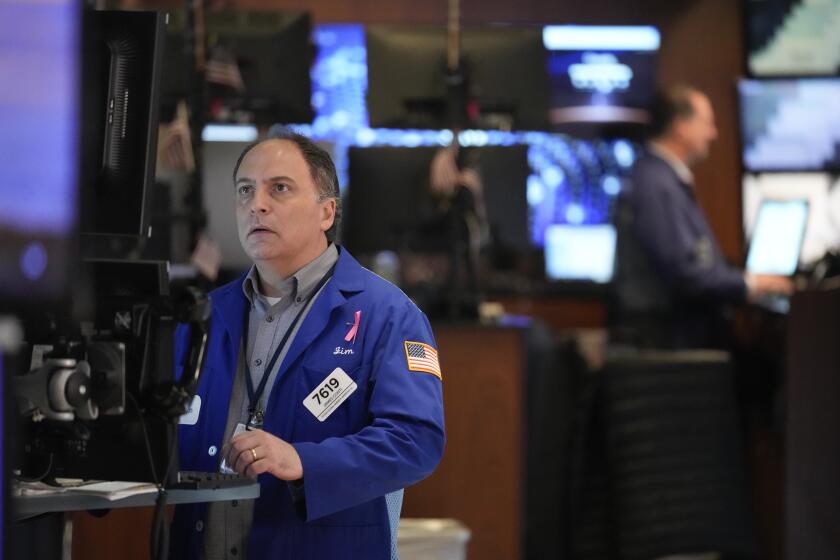Column: Trump’s trade war won’t achieve what he wants, but it will hurt American workers and consumers

One can hardly blame the stock market for being severely rattled by the proliferating signs of a trade war between the United States and the rest of the world.
It’s not merely that President Trump seems determined to toss aside decades of norms governing how global trading partners settle their inevitable differences, but that whatever his goals — and he hasn’t spoken especially cogently about what they are — they’re not likely to be achieved. But American workers and consumers may well end up as collateral victims of an increasingly uncertain and chaotic global trade system.
While the stock market does not always reflect the real economy, it can deliver clues to sentiment. And judging from Wednesday’s action, in which the Dow Jones industrial average traded in a nearly 800-point range before closing with a 231-point gain, the prevailing sentiment is nervousness. Indeed, the market has suffered a bout of extreme volatility since Trump took the first steps toward a global trade war last month.
Even if the U.S. were to ‘win’ a trade war, it would be largely a symbolic victory because the U.S. would also lose out on exports.
— Eswar Prasad, Brookings Institution
The economic sectors most at risk are American manufacturing, which Trump says he aims to protect; and agriculture, where growers of soybeans in the Midwest and nuts in California face the loss of significant foreign markets.
But Trump’s policies also threaten the flow of Chinese investment into the U.S.; that’s a particular threat to California, which has been the destination for one-fourth of all Chinese direct investment in the U.S. — more than $16 billion in 2016 alone.
Then there’s the damage done to America’s reputation as a reliable partner in trade negotiations. “All foreign governments would be wary of embarking on negotiations with the U.S. if they don’t have to,” says Gary Clyde Hufbauer, an expert on international trade policy at the Peterson Institute for International Economics.
For all the talk of a trade war, at the moment it’s still mostly talk. China on Wednesday issued a list of $50 billion in U.S. goods on which it might impose tariffs of 25%, including soybeans and aircraft. It’s unclear when those tariffs might actually take effect, if ever. But China’s move follows its imposition of 25% tariffs on 128 products, amounting to about $3 billion in U.S. exports, which took effect Monday. Those products include almonds, pistachios and wine, which are major California exports.
On Trump’s side, the attack on Chinese exports is still mostly rhetorical. Trump figuratively fired the first shot on March 1, when he announced plans to impose a 25% duty on imported steel and 10% on aluminum. Although rhetorically the action was aimed at China, he said at the time that he would make no distinctions among exporting countries.
That was a problem, because most steel imports come from U.S. allies, chiefly Canada, Mexico and South Korea. China’s steel exports amounted to only about $1 billion, or 3.35% of the import market. Moreover, 94% of China’s steel exports already are covered by U.S. tariffs. By the time the new tariffs went into effect, Trump had exempted Canada, Mexico, South Korea, the European Union and several other friendly steel producers.
Had they gone fully into effect, however, the steel tariffs would have been far more damaging to the broad U.S. economy than protective. In every state in which there are jobs in steel mills that would have been protected by tariffs, there are many more jobs in steel-dependent industries that might have been threatened by higher steel prices; in some states the disparity ran into hundreds of thousands of jobs. By one estimate, the tariffs would have created 33,000 U.S. jobs, but destroyed 173,000: As the Economist observed, Trump would be “screwing over two Rose Bowls of people for the sake of one Fenway Park.”
It’s true, as Commerce Secretary Wilbur Ross asserts in defense of the tariffs, that on an economy-wide level they would affect a vanishingly small share of U.S. gross domestic product — $50 billion, the value of goods targeted by China’s latest list, comes to about one-quarter of 1% of the $20-trillion U.S. economy.
“But the hit will be very concentrated,” Hufbauer observes. China ranks as the No. 1 export market for U.S. agricultural products, with soybeans accounting for two-thirds of the total. Soybean farmers in the Midwest, who export half their crop, would lose a market valued at more than $14 billion a year. California growers, especially of almonds and pistachios, would face the loss of $890 million in exports.
It may not be coincidental that while California is a blue state overall, the farm districts targeted by China import restrictions are mostly Trump country. Indeed, that’s true nationwide. According to a data analysis done by the Brookings Institution for Greg Sargent of the Washington Post, the industries targeted in China’s second round of threatened retaliatory tariffs provide more than 1.7 million jobs, of which nearly 886,000, or more than 51%, are in counties carried by Trump in the 2016 election.
The stakes for California in an expanded trade war with China are vast. With about $16.4 billion in sales to China, California is the nation’s second-largest export partner with China, next to Washington state.
“Nobody likes to be singled out,” David Phippen, 68, a third-generation almond farmer and partner in a family-owned Central Valley processing business, told me Wednesday. California almond growers send 7.5% of their crop to China annually — 150 million pounds of a total harvest of 2 billion pounds — making China their fourth-largest market. But with China imposing 25% tariffs on U.S. almonds, Phippen and his fellow growers expect to lose at least some of that business to Australia, their main competitor.
The full extent of the potential damage isn’t yet clear. “Some of us have shiploads on the water,” Phippen says. “We don’t know if the 25% will apply to them.”
The Chinese retaliation didn’t come as a complete surprise in the Central Valley. “We got nervous when President Trump started talking about imposing tariffs on steel,” Phippen says. “My radar went up.”
What’s especially irksome is that California growers had made a major effort over the last decade to develop the China trade, spending heavily on marketing to make almonds competitive with walnuts and pistachios, which were more popular among Chinese consumers.
California also depends on China for capital. Its $16 billion a year in investments, mostly in real estate and high-tech acquisitions, is half again as large as the money that flows into New York, the second-ranked state.
But those inflows are threatened by the Trump administration’s hostility to Chinese investment in the U.S. Treasury Secretary Steven Mnuchin says he has prepared proposals to restrict such investments beyond those subject to oversight by the Committee on Foreign Investment in the United States, or CFIUS, which vets foreign investments with national security implications.
“We’re moving from a situation where we had a narrow set of criteria,” says Nicholas R. Lardy, a China trade expert at the Peterson Institute, “to one where the U.S. objective seems to be to do everything we can to prevent China from moving up the technology ladder.”
Not only is that likely to be a futile quest, but it runs counter to interests of many states. “There’s a huge disconnect between the attitude in the administration and that of Gov. Jerry Brown and governors in the rest of the country,” Lardy says. Trump’s approach isn’t likely to please entrepreneurs and other investors. “If China wants to buy a firm for a price the board and shareholders think is a good deal,” Lardy says, “they should be permitted to do so.”
The real threat posed by Trump’s trade actions may be to international economic stability. To begin with, as Eswar Prasad of the Brookings Institution and Cornell University observes, tariffs are unlikely to have much impact on America’s trade deficits with China or any other trading partners. That’s because the target countries can simply impose countervailing tariffs on an equal volume of their imports from the U.S., leading to no net gain—as China has threatened to do. The result is a trade war—“an escalation of tit-for-tat trade restrictions imposed by countries on each other’s exports.”
As Prasad notes, “Trump has argued that trade wars are ‘good’ and ‘easy to win’...but even if the U.S. were to ‘win’ a trade war, it would be largely a symbolic victory because the U.S. would also lose out on exports.” More seriously, doubts about U.S. reliability or trustworthiness as a trade partner could damage its trade interests down the road.
It’s true that the existing international trade system as overseen by the World Trade Organization is imperfect. But it has been made to function as well as it does by general agreement to work around its imperfections and avoid exacerbating them. One element, for example, is the “national security” loophole allowing countries to impose tariffs that otherwise would not be accepted.
WTO members generally have avoided invoking the loophole because it forestalls challenges and opens the prospect of a wholesale collapse in trade relations. But Trump is citing national security as the rationale for his steel and aluminum tariffs, a pretext most observers consider a sham, given that the majority of steel and aluminum imports come from friendly countries. If Trump’s maneuver blows up the delicate structure of WTO oversight, no one will win.
Is that Trump’s goal? No one knows. He hasn’t articulated a coherent trade policy, and to the extent he has mentioned any principles, the steps he has taken won’t serve them. In trade, Lardy says, “The question that can’t be answered is what does the Trump administration want?”
Keep up to date with Michael Hiltzik. Follow @hiltzikm on Twitter, see his Facebook page, or email michael.hiltzik@latimes.com.
Return to Michael Hiltzik’s blog.
UPDATES:
9:50 a.m.:, April 5: This article was updated with comments from California almond farmer David Phippen and details about U.S. jobs likely to be affected by Chinese tariffs.
This article was originally published at 2:05 p.m., April 4.







